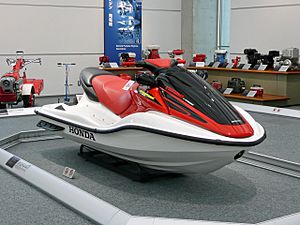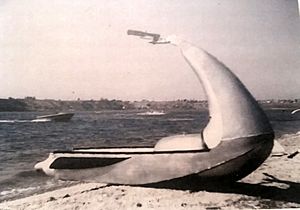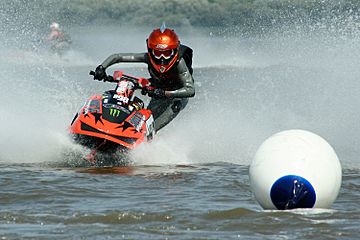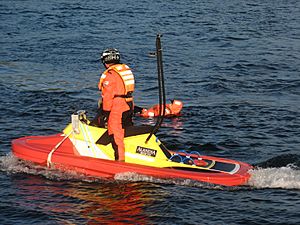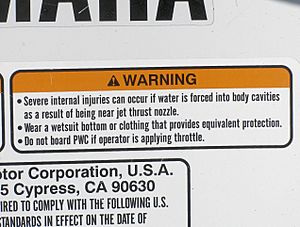Personal watercraft facts for kids
A personal watercraft (PWC) is a fun type of watercraft. People often call them water scooters or jet skis. Unlike a regular boat, you sit or stand on top of a PWC, not inside it.
There are two main kinds of PWCs. The most common one is like a small boat where you sit down, similar to riding a motorcycle. These usually hold two or three people. The other kind is a "stand-up" PWC, made for one person. You stand up to ride it, like a motorized scooter. Stand-up PWCs are often used for cool tricks, racing, and competitions. Both types have an engine inside that powers a special pump. This pump uses a spinning part called an impeller to push water out the back, making the PWC move and steer. Many modern PWCs can travel long distances, sometimes over 100 miles (160 km)!
You might hear PWCs called by their brand names. Some famous ones are Kawasaki's Jet Ski, Yamaha's WaveRunner, Bombardier's Sea-Doo, and Honda's AquaTrax. The United States Coast Guard says a PWC is a jet-powered boat less than 12 feet (3.7 m) long.
Contents
History of Personal Watercraft
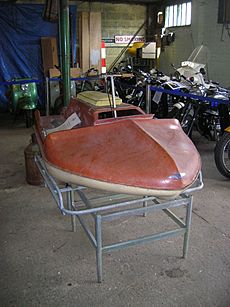
The idea of water scooters started in the 1950s in the United Kingdom and Europe. Early models included the British Vincent Amanda and the German Wave Roller. About 2,000 Vincent Amandas were sent to places like Australia, Asia, Europe, and the United States.
In 1961, the Sea Skimmer came out. It was like a surfboard that could move on its own. It was about 1.5 meters long and could go up to 40 kilometers per hour. The rider would lie on it, using hand controls for speed and their feet to steer. This design later became the Aqua-Skimmer and then the Aqua Dart, which was even used by the military for river missions.
A big step forward happened in the 1960s with Clayton Jacobson II from Lake Havasu City, Arizona. He loved motocross and wanted to create a similar experience on water. His idea was a PWC powered by an internal pump, not an outboard motor. He made his first working model in 1965 out of aluminum, and a fiberglass one a year later. These early designs looked a lot like the PWCs we see today.
The first PWC similar to Jacobson's design was made by Bombardier in the late 1960s. However, these weren't very popular at first. In Greece, an inventor named Dimitrios T. Moraitidis also patented a similar idea in 1970.
Stand-up PWCs were first mass-produced by the Japanese company Kawasaki in 1972, under their famous Jet Ski brand. They arrived in the US in 1973. While stand-up models are still made, the sit-down kind became much more popular. Today, major PWC makers include Kawasaki, Bombardier (Sea-Doo), and Yamaha (WaveRunner).
PWC Sports and Competitions
PWC racing is a popular sport around the world! There are different types of races and events:
- Closed circuit speed races: These are races on a marked course.
- Offshore speed races: Longer races out on open water.
- Endurance races: Testing how long riders and PWCs can last.
- Freestyle: Riders perform amazing tricks and stunts.
- Freeride: Similar to freestyle, often done in waves.
For speed races, PWCs are grouped by how much they've been changed. "Stock" means minor changes, "limited" means some changes, and "F1" means lots of changes for top performance. In freestyle, riders are grouped by whether they use stand-up or sit-down PWCs.
The main organization for this sport is the World Powerboating Federation (U.I.M.), which is recognized by the IOC. The biggest official competition is the Aquabike World Championship, which started in 1996. Many different countries compete in this championship, with over 140 riders from 32 nations joining in Italy in 2018!
Other private competitions also exist, like P1 AquaX. This racing series began in the UK in 2011 and later expanded to the USA. It has attracted many new riders to the sport. In the United States, the main groups that organize PWC sports are the International Jet Sport Boating Association (IJSBA) and Pro Watercross (PWX). The IJSBA World Finals are usually held in Lake Havasu City, Arizona, every October.
Non-Recreational Uses of PWCs
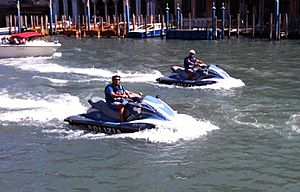
PWCs are not just for fun! They are small, fast, easy to handle, and don't have outside propellers, which can make them safer than some small boats around swimmers. Because of these features, they are used for many important jobs:
- Fishing: Fishing from a PWC is becoming very popular.
- Lifeguards and Rescue: Lifeguards use PWCs with special rescue platforms to help people in trouble in the water. They can also rescue people during floods.
- Law Enforcement: Police and park rangers use PWCs to patrol lakes, rivers, and coastal areas.
- Coaching: Some rowing coaches use PWCs with speakers and GPS to guide their teams.
- Military: The U.S. Navy even uses PWCs as targets for practice. They can be controlled from far away and are small enough to be carried on many ships.
Safety Tips for PWCs
Like any vehicle, riding a PWC has some risks, but you can stay safe by following rules and being careful.
- Wear protective gear: It's important to wear a wetsuit or similar protective clothing, especially on the bottom half of your body. This helps protect you if you fall off the PWC at speed.
- Be aware of the water jet: The PWC moves by shooting a powerful stream of water out the back. If you fall off, make sure you are not in the path of this jet.
- Steering: Some PWCs can't steer if you let go of the throttle. Always be aware of your surroundings and keep control.
- Jumping waves: While jumping waves can be fun, doing it too high or too often can be risky for your back. PWC manuals warn about this, especially if you have a history of back issues.
- Stay clear of the intake: The front part of the pump jet sucks water in. Keep loose clothing, long hair, and life vest straps away from this area when the engine is on.
Always read your PWC's owner's manual and follow all safety instructions to have a fun and safe ride!
See also
 In Spanish: Moto de agua para niños
In Spanish: Moto de agua para niños
- Aqua scooter (of historical interest)
- Flyboard
- Video games featuring personal watercraft:
- Jet X2O
- Splashdown
- Wave Race
- Wave Race 64
- Wave Race: Blue Storm
- Wetbike
- Yamaha Superjet
- Yamaha Wave Blaster
- Belassi Hypercraft


